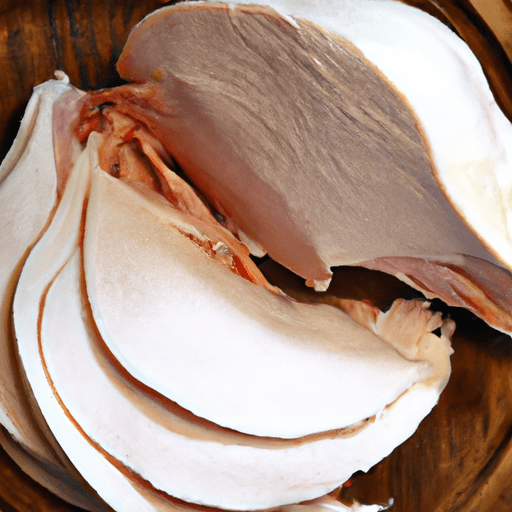The Versatile and Delicious Sliced Turkey Breast
When it comes to lean and flavorful meats, sliced turkey breast is a true winner. Whether you’re looking for a healthy protein source or simply a delicious addition to your sandwiches, salads, or main dishes, this versatile ingredient checks all the boxes. In this blog post, we’ll explore the taste, common uses, nutritional value, and some interesting facts about sliced turkey breast.
A Taste of Turkey
Sliced turkey breast offers a mild, savory flavor that pairs beautifully with a wide range of ingredients. Its tender and juicy texture makes it a favorite among both kids and adults. The flavor of turkey breast is often described as slightly sweet and earthy, with subtle hints of herbs and spices. If you’re a fan of white meat, you’ll certainly appreciate the delicate taste that sliced turkey breast brings to the table.
Common Uses in Cooking
One of the great things about sliced turkey breast is its versatility in the kitchen. Here are some popular ways to incorporate it into your culinary creations:
Sandwiches and Wraps: Sliced turkey breast is a classic choice for sandwiches. Layer it on your favorite bread with crisp lettuce, juicy tomatoes, and tangy condiments for a satisfying lunch option. You can also roll it up in a wrap or tortilla for a quick and easy meal on the go.
Salads: Add a protein boost to your salads by tossing in some sliced turkey breast. Its mild flavor blends well with a variety of greens, vegetables, and dressings. Use it as a topping for Caesar salads, Cobb salads, or mixed greens for a delicious and filling meal.
Main Dishes: Sliced turkey breast can take center stage in many main dishes. From turkey stir-fries and pasta dishes to turkey enchiladas and casseroles, the possibilities are endless. Its versatility allows you to experiment with different flavors and cuisines.
Charcuterie and Cheese Boards: Impress your guests by including sliced turkey breast on your charcuterie or cheese board. Its subtle taste pairs nicely with a variety of cheeses, fruits, and crackers, providing a delightful addition to any gathering.
Nutritional Value
Not only is sliced turkey breast delicious, but it also offers several nutritional benefits. Here’s a breakdown of its nutritional value per 3-ounce serving:
- Calories: 125
- Protein: 26g
- Fat: 1g
- Carbohydrates: 0g
- Cholesterol: 50mg
- Sodium: 359mg
- Potassium: 286mg
- Iron: 6% of the recommended daily intake
Sliced turkey breast is an excellent source of lean protein, making it a great choice for those looking to maintain a healthy diet. It is low in fat and carbohydrates, making it suitable for various dietary preferences.
Interesting History and Facts
Turkey has been enjoyed for centuries, and its popularity continues to grow worldwide. Here are a few interesting facts about the history of sliced turkey breast:
Native American Connection: Turkey is native to North America and was an important food source for Native American tribes. It is believed that European explorers brought turkeys back to Europe, where they quickly became an integral part of holiday feasts.
Thanksgiving Tradition: Turkey is synonymous with Thanksgiving in many cultures. This tradition dates back to the 17th century when English pilgrims celebrated their bountiful harvest with a feast that included wild turkeys.
Processed Deli Meat: Sliced turkey breast is widely available in delis and supermarkets. The technique of slicing turkey breast thinly and uniformly originated as a way to create deli-style meat that is easy to enjoy.
Turkey Trot: Turkey trot races, which are fun runs or walks held on or around Thanksgiving, have become a popular tradition in many communities. They offer participants a chance to burn calories before indulging in a delicious turkey feast.
In Conclusion
Sliced turkey breast is a versatile and delicious ingredient that brings flavor and nutrition to any dish. Whether you’re making a satisfying sandwich, a vibrant salad, or a hearty main course, this lean meat is sure to delight your taste buds. So, next time you’re planning your menu, don’t forget to add sliced turkey breast to the list! Its mild taste, countless culinary uses, and impressive nutritional profile make it a fantastic choice for any occasion.
Sliced Turkey Breast
Origin: Turkey meat comes from the domesticated turkey, which is native to North America. Turkeys were first domesticated by Native Americans over 2,000 years ago.
Common Uses: Sliced turkey breast is commonly used as a deli meat in sandwiches, wraps, and salads. It can also be used in casseroles, soups, and as a topping on pizzas.
Nutritional Benefits: Sliced turkey breast is low in fat and calories, making it a healthier protein option. It is a good source of lean protein, providing essential amino acids necessary for the growth and repair of body tissues. It contains important nutrients such as vitamins B6 and B12, niacin, selenium, and zinc.
Unique Properties: Turkey breast is known for its mild flavor and tender texture when properly cooked. It can be roasted, smoked, or grilled to enhance its taste. It is often sliced thin for deli-style purposes.
Historical Significance: Turkeys have been a part of Native American culture for centuries. They were a valuable food source and were considered sacred by some tribes. Today, turkey is traditionally associated with Thanksgiving meals in the United States, where roasted turkey is the centerpiece of the holiday feast.




Use the share button below if you liked it.
It makes me smile, when I see it.